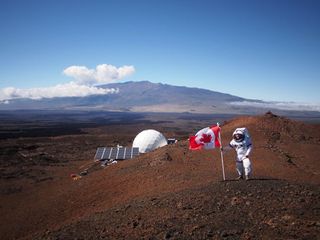
Six mock Mars mission crewmembers are preparing to come back to the real world at the end of the week.
The second Hawaii Space Exploration Analog & Simulation mission, known as Hi-SEAS 2, wraps up on Friday (July 25), ending four months of simulated Mars exploration on Hawaii's Mauna Loa volcano.
Commander Casey Stedman and his five crewmates entered their "Mars habitat" — a 36-foot-wide (11 meters), solar-powered structure — on the night of March 28, tasked with helping bring a bona fide manned Red Planet mission a bit closer to reality. [The 9 Coolest Mock Space Missions]
HI-SEAS "is a program designed to operate a simulated environment to test what will be necessary for future astronauts to live on the surface of Mars for an extended period of time," Stedman, an officer in the U.S. Air Force Reserve, wrote in a blog post shortly after HI-SEAS 2 kicked off. "The challenges future human missions to Mars will face are not easily duplicated on Earth. But through careful planning, analog studies can simulate some the factors in order to better prepare us."
The HI-SEAS 2 crew have lived inside their habitat on Mauna Loa's slopes for the past four months, venturing outside only to conduct "Marswalks" in mock spacesuits. In addition to Stedman, the team includes physics Ph.D. student Ross Lockwood, spaceflight research assisant Tiffany Swarmer, space-engineering Ph.D. candidate Lucie Poulet, NASA scientist Anne Caraccio and neuropyschologist Ronald Williams.
The six crewmembers have been conducting a number of different research projects during the mission. They're investigating how to improve spacewalk design and execution, for example, and how well plants grow under different wavelengths of light. And Williams is keeping a close eye on everyone's psychological health.

"My individual research here involves psychological and emotional adjustment to long-term confinement, such as we're experiencing here and as would be present on a long-term space voyage," Williams said in a HI-SEAS 2 video posted in May. "I'm using measures of cognitive ability as well as personality inventories and relating those to how well the crew adjusts emotionally over a period of time."
Get the Space.com Newsletter
Breaking space news, the latest updates on rocket launches, skywatching events and more!
HI-SEAS 2 is run by the University of Hawaii at Manoa and funded by NASA's Human Research Program. The 118-day HI-SEAS 1 mission, which focused on how best to feed astronauts during a mission to the Red Planet, wrapped up in August 2013.
Mars is the main long-term goal of NASA's human spaceflight program. The agency aims to get astronauts to the vicinity of the Red Planet by the mid-2030s, to meet a directive issued by President Barack Obama in 2010.
Follow Mike Wall on Twitter @michaeldwall and Google+. Follow us @Spacedotcom, Facebook or Google+. Originally published on Space.c om.
Join our Space Forums to keep talking space on the latest missions, night sky and more! And if you have a news tip, correction or comment, let us know at: community@space.com.

Michael Wall is a Senior Space Writer with Space.com and joined the team in 2010. He primarily covers exoplanets, spaceflight and military space, but has been known to dabble in the space art beat. His book about the search for alien life, "Out There," was published on Nov. 13, 2018. Before becoming a science writer, Michael worked as a herpetologist and wildlife biologist. He has a Ph.D. in evolutionary biology from the University of Sydney, Australia, a bachelor's degree from the University of Arizona, and a graduate certificate in science writing from the University of California, Santa Cruz. To find out what his latest project is, you can follow Michael on Twitter.
